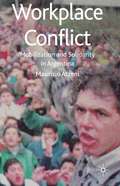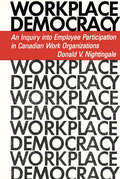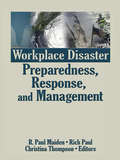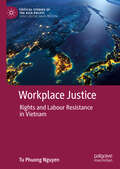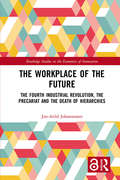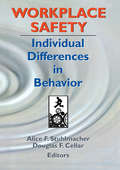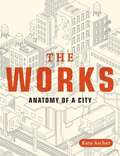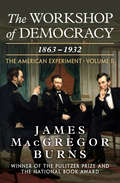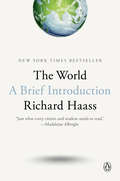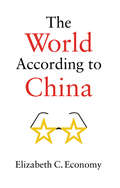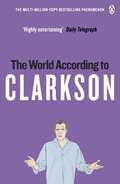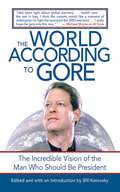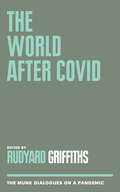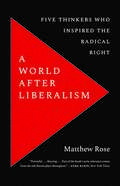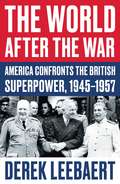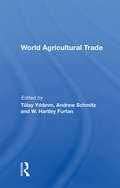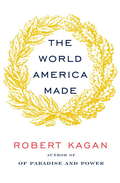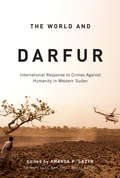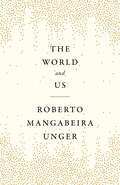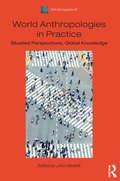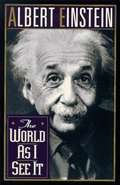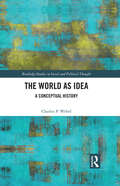- Table View
- List View
Workplace Conflict
by Maurizio AtzeniBased on qualitative work in car plants in Argentina, this bookoffers new insights for an understanding of workers' collective struggles in a radical perspective. Criticizing the use of injustice as the basis of mobilization, it argues that workers' collective resistance should be seen as a function of the development of solidarity. "
Workplace Democracy
by Donald V. NightingaleThis book begins with a historical review of how authority in the Canadian workplace has changed over the past century. It proceeds to outline a theory of organization which provides a broad conceptual framework for the empirical analysis which follows. This theory is based on five concepts: the values of organizational members; the administrative structure of the organization; the interpersonal and intergroup processes; the reactions and adjustments of organization members; the social, political, economic, and cultural environments of the organization.A sample of 20 industrial organizations was selected to examine the effects of significant employee participation and to test the theory. They are matched pairs: ten permit some form of participation, and ten--similar in size, location, industry, union/non-union status, and work technology--follow conventional hierarchical design.The resulting data demonstrate that greater productivity results from employee participation in decisions relating to their work, in productivity bonuses, and in profit sharing and employee share-ownership plans.
Workplace Disaster Preparedness, Response, and Management
by Christina Thompson R. Paul Maiden Rich PaulRespond quickly and effectively to workplace traumaFor years, employee assistance programs have been providing critical incidence stress management services to employees who have been involved in, or witness to, workplace fatalities and accidents that are likely to traumatize workers and affect quality of work and increase sick leave and health claims. Workplace Disaster Preparedness, Response, and Management presents successful strategies for rapid response to episodes of workplace violence, natural disasters, and acts of terrorism that have become all-too-common occurrences in the workplace. Workplace Disaster Preparedness, Response, and Management is a must read for professionals in the business of providing crisis response services and for employers responsible for planning and coordinating organizational responses to disasters. This unique book presents first-hand accounts from EAP program managers, Critical Incident Stress Management (CISM) professionals, and crisis managers on their trauma response techniques and from health professionals involved in the aftermath of Hurricane Katrina and the Sept. 11 attacks on the World Trade Centers and the Pentagon. Workplace Disaster Preparedness, Response, and Management examines: similar and dissimilar experiences of EAP professionals in responding to large scale traumatic events using military models in trauma response managing trauma in the South African mining industry trauma response techniques in high risk work settings compassion fatigue among professional helpers how various types of industries handle critical incidents EAP responses to natural disasters repetitious violence in the workplace organizational crisis intervention and much moreWorkplace Disaster Preparedness, Response, and Management also includes Bern Beidel’s first-person account as EAP Director for the United States House of Representatives of the response to anthrax contamination in mailrooms and office buildings in the nation’s capital.
Workplace Flexibility: Realigning 20th-Century Jobs for a 21st-Century Workforce
by Kathleen Christensen Barbara SchneiderAlthough today's family has changed, the workplace has not--and the resulting one-size-fits-all workplace has become profoundly mismatched to the needs of an increasingly diverse and varied workforce. As changes in the composition of the workforce exert new demands on employers, considerable attention is being paid to how workplaces can be structured more flexibly to achieve the goals of employers and employees. Workplace Flexibility brings together sixteen essays authored by leading experts in economics, demography, political science, law, sociology, anthropology, and management. Collectively, they make the case for workplace flexibility, as well as examine existing business practices and public policy regarding flexibility in the United States, Europe, Australia, and Japan. Workplace Flexibility underscores the need to realign the structure of work in time and place with the needs of the changing workforce. Considering the positive and negative consequences for employer and employee alike, the authors argue that, although there is not an easy solution to creating and implementing flexibility practices--in the United States or abroad--redesigning the workplace is essential if today's workers are effectively to meet the demands of life and work and if employers are successfully able to attract and retain top talent and improve performance.
Workplace Justice: Rights and Labour Resistance in Vietnam (Critical Studies of the Asia-Pacific)
by Tu Phuong NguyenThis book develops an understanding of workplace justice and labour rights in Vietnam from factory workers’ voices and their resistance against abuse and exploitation. Through interviews with workers and a close analysis of their letters and petitions to the unions and state authorities, Nguyen illuminates how workers’ resistance is enabled and stifled by the legal and political systems that are supposed to protect their rights and benefits. Their calls for justice reflect socialist ideology and widely held norms within society, as well as ideals and values embedded in labour law. The book demonstrates how state law brings about social change through shaping workers’ expectations and increasing consciousness of rights and justice. This book will be of interest to scholars of law, politics and society, and scholars, students and practitioners interested in labour rights in developing countries.
The Workplace of the Future: The Fourth Industrial Revolution, the Precariat and the Death of Hierarchies (Routledge Studies in the Economics of Innovation)
by Jon-Arild JohannessenThe Fourth Industrial Revolution is a global development that shows no signs of slowing down. In his book, The Workplace of the Future: The Fourth Industrial Revolution, the Precariat and the Death of Hierarchies, Jon-Arild Johannessen sets a chilling vision of how robots and artificial intelligence will completely disrupt and transform working life. The author contests that once the dust has settled from the Fourth Industrial Revolution, workplaces and professions will be unrecognizable and we will see the rise of a new social class: the precariat. We will live side by side with the 'working poor' – people who have several jobs, but still can’t make ends meet. There will be a small salaried elite consisting of innovation and knowledge workers. Slightly further into the future, there will be a major transformation in professional environments. Johannessen also presents a typology for the precariat, the uncertain work that is created and develops a framework for the working poor, as well as for future innovation and knowledge workers, and sets out a new structure for the social hierarchy. A fascinating and thought-provoking insight into the impact of the Fourth Industrial Revolution, The Workplace of the Future will be of interest to professionals and academics alike. The book is particularly suited to academic courses in management, economy, political science and social sciences.
Workplace Safety: Individual Differences in Behavior
by Alice F Stuhlmacher Douglas F CellarDo all you can to minimize dangerous behaviors to benefit communities, employees, and organizations!Safety is a “real world” problem that community psychologists, industrial/organizational psychologists, industrial hygenists, human resources professionals, and corporate insurance groups must deal with on a day-to-day basis. In Workplace Safety: Individual Differences in Behavior you will examine safety behavior and discover practical interventions to help increase the safety awareness of the people in your life. This book takes a look at ways of defining and measuring safety as well as a variety of individual differences like gender, job knowledge, conscientiousness, self-efficacy, risk avoidance, and stress tolerance that are important in creating safety interventions and improving the selection and training of employees.Workplace safety is of prime importance in today's increasingly litigious society. It has been estimated that each year in the United States, there are 100,000 work-related accident or disease fatalities, 400,000 workers who become disabled, and 6 million workplace injuries. Of equal importance are driver safety and safety hazards in public spaces such as malls and individual stores. Workplace Safety: Individual Differences in Behavior examines: the importance of measurement in understanding worker abilities and defining safety behaviors the often-neglected issue of gender differences in safety definitions and research the relationship between personality variables, job, knowledge, and accident involvement the five-factor personality model for predicting safety behavior a model of safety consciousness types of safety hazards in public spaces monetary costs of accidents in malls and stores a practitioner's perspective on individual differences in safety behaviorWorkplace Safety: Individual Differences in Behavior takes an incisive look at these issues with a unique focus on the way individual differences in people impact safety behavior in the real world.
The Works: Anatomy Of A City
by Kate Ascher Wendy Marech Alexander Isley IncA fascinating guided tour of the ways things work in a modern city Have you ever wondered how the water in your faucet gets there? Where your garbage goes? What the pipes under city streets do? How bananas from Ecuador get to your local market? Why radiators in apartment buildings clang? Using New York City as its point of reference, The Works takes readers down manholes and behind the scenes to explain exactly how an urban infrastructure operates. Deftly weaving text and graphics, author Kate Ascher explores the systems that manage water, traffic, sewage and garbage, subways, electricity, mail, and much more. Full of fascinating facts and anecdotes, The Works gives readers a unique glimpse at what lies behind and beneath urban life in the twenty-first century.
The Workshop of Democracy, 1863–1932 (The American Experiment #2)
by James MacGregor BurnsThe second volume of Burns&’s acclaimed history of America, from the end of the Civil War to the beginning of the Great Depression Abraham Lincoln&’s Gettysburg Address pointed to a new way to preserve an old hope—that democracy might prove a vibrant and lasting form of government for people of different races, religions, and aspirations. The scars of the Civil War would not soon heal, but with that one short speech, the president held out the possibility that such a nation might not simply survive, but flourish. The Workshop of Democracy explores more than a half-century of dramatic growth and transformation of the American landscape, through the addition of dozens of new states, the shattering tragedy of the First World War, the explosion of industry, and, in the end, the emergence of the United States as an new global power.
The World: A Brief Introduction
by Richard HaassThe New York Times bestseller&“A clear and concise account of the history, diplomacy, economics, and societal forces that have molded the modern global system.&” —Foreign AffairsAn invaluable primer from Richard Haass, president of the Council on Foreign Relations, that will help anyone, expert and non-expert alike, navigate a time in which many of our biggest challenges come from the world beyond our borders.Like it or not, we live in a global era, in which what happens thousands of miles away has the ability to affect our lives. This time, it is a Coronavirus known as Covid-19, which originated in a Chinese city many had never heard of but has spread to the corners of the earth. Next time it could well be another infectious disease from somewhere else. Twenty years ago it was a group of terrorists trained in Afghanistan and armed with box-cutters who commandeered four airplanes and flew them into buildings (and in one case a field) and claimed nearly three thousand lives. Next time it could be terrorists who use a truck bomb or gain access to a weapon of mass destruction. In 2016 hackers in a nondescript office building in Russia traveled virtually in cyberspace to manipulate America's elections. Now they have burrowed into our political life. In recent years, severe hurricanes and large fires linked to climate change have ravaged parts of the earth; in the future we can anticipate even more serious natural disasters. In 2008, it was a global financial crisis caused by mortgage-backed securities in America, but one day it could well be a financial contagion originating in Europe, Asia, or Africa. This is the new normal of the 21st century.The World is designed to provide readers of any age and experience with the essential background and building blocks they need to make sense of this complicated and interconnected world. It will empower them to manage the flood of daily news. Readers will become more informed, discerning citizens, better able to arrive at sound, independent judgments. While it is impossible to predict what the next crisis will be or where it will originate, those who read The World will have what they need to understand its basics and the principal choices for how to respond.In short, this book will make readers more globally literate and put them in a position to make sense of this era. Global literacy--knowing how the world works—is a must, as what goes on outside a country matters enormously to what happens inside. Although the United States is bordered by two oceans, those oceans are not moats. And the so-called Vegas rule—what happens there stays there—does not apply in today's world to anyone anywhere. U.S. foreign policy is uniquely American, but the world Americans seek to shape is not. Globalization can be both good and bad, but it is not something that individuals or countries can opt out of. Even if we want to ignore the world, it will not ignore us. The choice we face is how to respond.We are connected to this world in all sorts of ways. We need to better understand it, both its promise and its threats, in order to make informed choices, be it as students, citizens, voters, parents, employees, or investors. To help readers do just that, The World focuses on essential history, what makes each region of the world tick, the many challenges globalization presents, and the most influential countries, events, and ideas. Explaining complex ideas with wisdom and clarity, Richard Haass's The World is an evergreen book that will remain relevant and useful as history continues to unfold.
The World According to China
by Elizabeth C. EconomyAn economic and military superpower with 20 percent of the world’s population, China has the wherewithal to transform the international system. Xi Jinping’s bold calls for China to “lead in the reform of the global governance system” suggest that he has just such an ambition. But how does he plan to realize it? And what does it mean for the rest of the world? In this compelling book, Elizabeth Economy reveals China’s ambitious new strategy to reclaim the country’s past glory and reshape the geostrategic landscape in dramatic new ways. Xi’s vision is one of Chinese centrality on the global stage, in which the mainland has realized its sovereignty claims over Hong Kong, Taiwan, and the South China Sea, deepened its global political, economic, and security reach through its grand-scale Belt and Road Initiative, and used its leadership in the United Nations and other institutions to align international norms and values, particularly around human rights, with those of China. It is a world radically different from that of today. The international community needs to understand and respond to the great risks, as well as the potential opportunities, of a world rebuilt by China.
The World According to Clarkson: The World According to Clarkson Volume 1 (The World According to Clarkson #1)
by Jeremy ClarksonJeremy Clarkson, shares his opinions on just about everything in The World According to Clarkson. Jeremy Clarkson has seen rather more of the world than most. He has, as they say, been around a bit. And as a result, he's got one or two things to tell us about how it all works - and being Jeremy Clarkson he's not about to voice them quietly, humbly and without great dollops of humour. In The World According to Clarkson, he reveals why it is that:• Too much science is bad for our health• '70s rock music is nothing to be ashamed of• Hunting foxes while drunk and wearing night-sights is neither big nor clever• We must work harder to get rid of cricket• He liked the Germans (well, sometimes)With a strong dose of common sense that is rarely, if ever, found inside the M25, Clarkson hilariously attacks the pompous, the ridiculous, the absurd and the downright idiotic, whilst also celebrating the eccentric, the clever and the sheer bloody brilliant. Less a manifesto for living and more a road map to modern life, The World According to Clarkson is the funniest book you'll read this year. Don't leave home without it.The World According to Clarkson is a hilarious collection of Jeremy's Sunday Times columns and the first in his The World According to Clarkson series which also includes And Another Thing . . . , For Crying Out Loud! and How Hard Can It Be?Praise for Jeremy Clarkson:'Brilliant . . . laugh-out-loud' Daily Telegraph'Outrageously funny . . . will have you in stitches' Time OutNumber-one bestseller and presenter of the hugely popular Top Gear, Jeremy Clarkson writes on cars, current affairs and anything else that annoys him in his sharp and funny collections. Born To Be Riled, Clarkson On Cars, Don't Stop Me Now, Driven To Distraction, Round the Bend, Motorworld, and I Know You Got Soul are also available as Penguin paperbacks; the Penguin App iClarkson: The Book of Carscan be downloaded on the App Store.
The World According to Gore: The Incredible Vision of the Man Who Should Be President
by Bill KatovskyFrom election "loser," to bearded recluse, to dynamic Oscar, Emmy, and Nobel Prize winner: Al Gore has come a long way since 2000, and he has chronicled his up-and-down post-Washington journey in books, editorials, speeches, and interviews. In The World According to Gore, Bill Katovsky collects the best of the former vice president's writings and sayings, and gives us a picture of the new Al Gore that is more revealing and up-to-date than any other. Gore speaks out-on the environment, that election, the Bush presidency, and the next election. The World According to Gore shows that Gore is still our foremost prophet on the climate crisis, technology, and the war on terror, and more, and that he will have a major impact the 2008 presidential election-whether he decides to run or not.
The World After COVID: The Munk Dialogues on a Pandemic (The Munk Debates)
by Rudyard GriffithsFrom the world-renowned Munk Debates comes a collection of dialogues by leading intellectuals envisioning our post-pandemic future. During this time of social distancing, the acclaimed Munk Debates series have been reimagined into a series of dialogues by leading intellectuals who examine the geopolitical, economic, technological, and historical angles of this unprecedented new era. How will the world look after COVID-19? What is the future for the international economy and institutions? Will the global balance of power shift? Can technology save us? These are the questions that have occupied the best minds since the beginning of the pandemic. In a series of one-on-one conversations with moderator Rudyard Griffiths, renowned author Malcolm Gladwell, journalist Fareed Zakaria, and New York Times columnist David Brooks, along with six other thinkers, dissect what brought us here and what comes next.
A World after Liberalism: Philosophers of the Radical Right
by Matthew RoseA bracing account of liberalism&’s most radical critics, introducing one of the most controversial movements of the twentieth century In this eye-opening book, Matthew Rose introduces us to one of the most controversial intellectual movements of the twentieth century, the &“radical right,&” and discusses its adherents&’ different attempts to imagine political societies after the death or decline of liberalism. Questioning democracy&’s most basic norms and practices, these critics rejected ideas about human equality, minority rights, religious toleration, and cultural pluralism not out of implicit biases, but out of explicit principle. They disagree profoundly on race, religion, economics, and political strategy, but they all agree that a postliberal political life will soon be possible. Focusing on the work of Oswald Spengler, Julius Evola, Francis Parker Yockey, Alain de Benoist, and Samuel Francis, Rose shows how such thinkers are animated by religious aspirations and anxieties that are ultimately in tension with Christian teachings and the secular values those teachings birthed in modernity.
The World After the War: America Confronts the British Superpower, 1945–1957
by Derek LeebaertOne of the great myths of the twentieth century is that after the Second World War Britain simply relinquished its power and America quickly embraced its worldwide political and military commitments. Instead the two allies improvised an uneasy, shifting partnership for twelve long years while most of western Europe lay in turmoil and Russia grew more aggressive. But in 1957 Washington issued a &‘declaration of independence&’ from British authority. It was then that everything changed, and America assumed leadership of the new world order just taking shape. Derek Leebaert spins a riveting global narrative of Britain as the original superpower and shows why the Americans kept believing it to be indispensable. It&’s the story of secret ties, diplomatic quarrels and military interventions that casts political giants Churchill, Truman, Eisenhower and Johnson in a new light. In a volatile world of decolonisation, a uniting Europe and the Suez Crisis, shrewd men in London were leveraging the empire&’s long-established resources and influence to maintain their grip on power. The enduring notion of a special relationship, rising tensions with Russia and China, and the sources of much of the world&’s turmoil can&’t be understood without knowing what really occurred.
World Agricultural Trade
by Andrew SchmitzBetween 1961 and 1983, Turkish agriculture was subject to negative protection as a result of indirect measures, such as macroeconomic policies and industrial protection. Until the early 1980s, Turkey maintained an overvalued exchange rate, which served as an implicit tax on Turkish farmers. This policy was changed in 1982 when Turkey allowed its
The World America Made: The Munk Debate On America Foreign Policy (Munk Debates)
by Robert KaganWhat would the world look like if America were to reduce its role as a global leader in order to focus all its energies on solving its problems at home? And is America really in decline? Robert Kagan, New York Times best-selling author and one of the country's most influential strategic thinkers, paints a vivid, alarming picture of what the world might look like if the United States were truly to let its influence wane. Although Kagan asserts that much of the current pessimism is misplaced, he warns that if America were indeed to commit "preemptive superpower suicide," the world would see the return of war among rising nations as they jostle for power; the retreat of democracy around the world as Vladimir Putin's Russia and authoritarian China acquire more clout; and the weakening of the global free-market economy, which the United States created and has supported for more than sixty years. We've seen this before--in the breakdown of the Roman Empire and the collapse of the European order in World War I. Potent, incisive, and engaging, The World America Made is a reminder that the American world order is worth preserving, and America dare not decline.
The World and Africa
by W. E. B. Du BoisA inquiry into the important role that Africa and African people have played in world history.
The World and Darfur: International Response to Crimes Against Humanity in Western Sudan (Arts Insights Series #24)
by Amanda F. GrzybThis updated edition of The World and Darfur brings together genocide scholars from a range of disciplines - social history, art history, military history, African studies, media studies, literature, political science, and sociology - to provide a cohesive and nuanced understanding of the international response to the crisis in Western Sudan. Contributing authors, including Eric Reeves, Frank Chalk, Eric Markusen, and Samuel Totten, look at the lessons learned from the United Nations' failure to intervene during the Rwandan genocide, the representation of Darfur in the mainstream media, atrocity investigations, activist and NGO campaigns, art exhibitions and political rhetoric, and the role of the international community in the discourse of genocide prevention and intervention. For a complete list of contributors please visit www.mqup.ca
The World and Richard Nixon
by C. L. SulzbergerFormer New York Times foreign correspondent C.L. Sulzberger reviews Nixon's president specifically from a foreign affairs perspective.
The World and Us
by Roberto Mangabeira Unger"A restless visionary striving to realize the highest aspirations of modernity itself."–New York TimesA radical re-envisioning of the human condition by the acclaimed Brazilian philosopherIn The World and Us, Roberto Mangabeira Unger sets out to reinvent philosophy. His central theme is our transcendence, everything in our existence points beyond itself, and its relation to our finitude: everything that surrounds us, and we ourselves, are flawed and ephemeral.He asks how we can live so that we die only once, instead of dying many small deaths; how we can breathe new life and new meaning into the revolutionary movement that has aroused humanity for the last three centuries, but that is now weakened and disoriented; and how we can make sense of ourselves without claiming for human beings a miraculous exception to the general regime of nature. For Unger, philosophy must be the mind on fire, insisting on our prerogative to speak to what matters most.From this perspective, he redefines each of the traditional parts of philosophy, from ontology and epistemology to ethics and politics. He turns moral philosophy into an exploration of the contest between the two most powerful contemporary moral visions: an ethic of self-fashioning and non-conformity, and an ethic of human connection and responsibility.And he turns political philosophy into a program of deep freedom, showing how to democratize the market economy, energize democratic politics, and give the individual worker and citizen the means to flourish amid permanent innovation.
World Anthropologies in Practice: Situated Perspectives, Global Knowledge (Association Of Social Anthropologists Monographs)
by John GledhillIn a post-colonial world, the contributions of anthropologists living outside North America and Western Europe can no longer be treated as marginal. World Anthropologies in Practice demonstrates how global dialogues enable us to draw on local knowledge as well as differences of perspective to help overcome anthropology’s eternal struggle against ethnocentrism and to strengthen the subject’s relevance to the contemporary world.Based on contributions to the ASA-sponsored IUAES World Anthropology Congress in Manchester, UK, this truly global book brings together a wide range of international scholars who might otherwise not talk to each other. Featuring articles from leading figures in the field such as Yolanda Moses, Winnie Lem, Carmen Rial, Miriam Grossi, and Cristina Amescua, the volume covers topics as diverse as the mobility of Brazilian football players, toilets in South Africa, trade unions in Nepal and South Africa, peace-building in southern Thailand, museological approaches in China, the Great East Japan earthquake and tsunami, immigration and race in the United States, and many more. Edited by John Gledhill, the text offers a much-needed insight into the way in which anthropology is developing worldwide and makes a tremendous contribution to the discussion of ‘world anthropologies’. An important, timely work for students and researchers.
The World As I See It
by Albert EinsteinTranslated by Alan Harris. This book is the authorized English translation of the volume 'Mein Weltbild' by Albert Einstein in which he talks about his views on politics, religion, morality, and the place of science in the modern world.
The World as Idea: A Conceptual History (Routledge Studies in Social and Political Thought)
by Charles P. WebelIn The World as Idea Charles P. Webel presents an intellectual history of one of the most influential concepts known to humanity—that of "the world." Webel traces the development of "the world" through the past, depicting the history of the world as an intellectual construct from its roots in ancient creation myths of the cosmos, to contemporary speculations about multiverses. He simultaneously offers probing analyses and critiques of "the world as idea" from thinkers ranging from Plato, Aristotle, and St. Augustine in the Greco-Roman period to Kant, Schopenhauer, Nietzsche, Wittgenstein, Merleau-Ponty, and Derrida in modern times. While Webel mainly focuses on Occidental philosophical, theological, and cosmological notions of worldhood and worldliness, he also highlights important non-Western equivalents prominent in Islamic and Asian spiritual traditions. This ensures the book is a unique overview of what we all take for granted in our daily existence, but seldom if ever contemplate—the world as the uniquely meaningful environment for our lives in particular and for life on Earth in general. The World as Idea will be of great interest to those interested in the "world as idea," scholars in fields ranging from philosophy and intellectual history to political and social theory, and students studying philosophy, the history of ideas, and humanities courses, both general and specialized.
